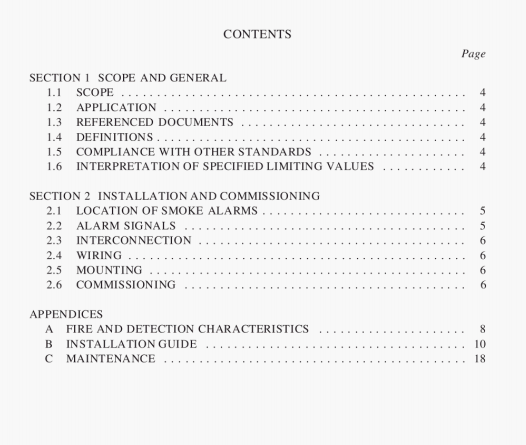AS 1670.6:1997 pdf – Fire detection, warning,controland intercom systems-Systemdesign, installation and commissioning Part 6: Smoke alarms.
A.l GENERAL. Fire is a leading cause of accidental death. Residential occupancies account for most fire fatalities and most of these deaths occur at night during the sleeping hours. Statistics indicate that a family will experience one serious fire every generation.
Due to the variety of combustibles and conditions in the family home the nature of fires will vary widely. Following ignition, a fire may break out in flames almost immediately or smoulder for several hours before breaking out in flames. Some types of detectors are more appropriate than others for specific types of fires and consideration should be given to smoke alarm selection.
2 FIRE GROWTH During the smouldering stage, a fire will release a small amount of heat, possibly toxic gases, and airborne matter in a variety of particle sizes. Particulate matter and toxic fume inhalation is the most common cause of death in house fires. Following the onset of flaming, the fire will grow in size and spread rapidly, fuelled by the surrounding combustible material and the heat produced by the fire. The rate of fire spread in any specific case will depend on the flammability of interior contents, including furnishings, the surtice materials of ceilings, walls and floors, and the oxygen supply.
During the flaming stage, with adequate air supply various gases and particulate matter released will be approximately proportional to the fire size. Where the air supply is restricted, as may be the case in a closed living unit, oxygen depletion will occur and carbon monoxide production will increase as the fire grows.
A3 FIRE BY-PRODUCTS The most threatening by-product of a fire and one of special consideration where fire deaths are concerned is carbon monoxide. All materials, when burned, release carbon monoxide—some synthetic materials at much higher rates. Test fires of simulated living rooms show that furniture upholstered with polyurethane foam is capable of producing lethal concentrations of carbon monoxide within one or two minutes of ignition. Carbon monoxide interferes with the ability of blood to carry oxygen to the brain, causing confusion, disorientation and unconsciousness. A person exposed to high levels of carbon monoxide would he unconscious after a few breaths and death would follow in one to three minutes. The carbon monoxide given off from a fire could be likened to pumping a car exhaust into the home.
At a certain stage of the fire, the cumulative effects of overheated air, toxic gases and oxygen deficiency will overcome any occupants. Since the time available for escape is dependent on the stage at which the fire is detected and on the rate of fire spread. maximum protection is achieved by detection of the fire at its earliest stage.
A4 ALARM SELECTION
A4.l General The object of any smoke alarm is to provide early warning of a fire in order to maximize escape time. Whilst attempting to reach the same objective, different detection principles, such as ionization or photoelectric, behave differently. In deciding which type to install, consideration needs to be given to the likely type of fire (smouldering or fast flaming) and therefore the type of particulate matter and gases to he detected. The ambient conditions and the likelihood of the installation creating an unacceptable level of nuisance alarms should also be considered. A mixture of alarm types may he required to optimize detection results.
AS 1670.6:1997 pdf – Fire detection, warning,controland intercom systems-Systemdesign, installation and commissioning Part 6: Smoke alarms
